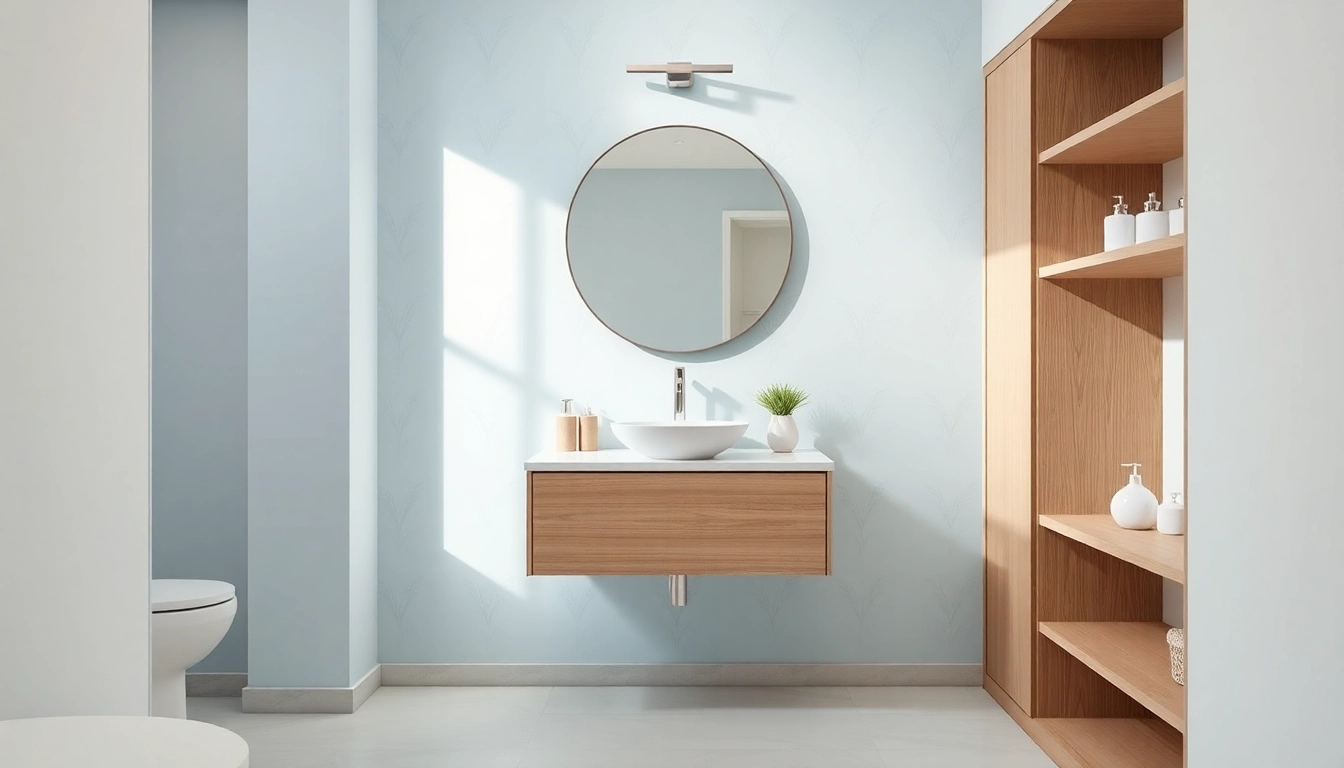Understanding Small Bathroom Remodels
Remodeling a small bathroom can be a daunting task, but with the right planning and vision, it can transform into a functional space that reflects your personal style. Whether you’re looking to enhance the aesthetics, boost functionality, or increase home value, understanding the intricacies of small bathroom remodels is essential. This comprehensive guide explores various aspects of remodeling small bathrooms, from defining the scope to executing the renovations effectively.
Defining the Scope of Your Remodel
Before diving into your small bathroom remodel, it’s crucial to define the project scope clearly. Ask yourself the following questions:
- What are the main goals of the remodel?
- Are you looking for a cosmetic upgrade, or do you need to address structural issues?
- What features do you want to keep, and what do you plan to replace?
- Will the remodel be DIY, or will you require professional assistance?
These questions will help guide your decisions throughout the remodeling process, ensuring that you stay on track and meet your expectations.
Identifying Key Design Elements
In small bathrooms, every design choice counts. Consider these key elements:
- Color Scheme: Light colors can make a small space appear larger, while darker hues can create a dramatic effect. Accents of color can add personality without overwhelming the space.
- Fixtures and Fittings: Selecting the right fixtures—such as taps, sinks, and toilets—can affect both style and functionality. Compact, modern fixtures are ideal for conserving space.
- Storage Solutions: Innovative storage, such as floating shelves and built-in cabinetry, can maximize space and reduce clutter.
Setting a Realistic Budget for Your Project
A budget is an essential part of any remodeling project. A small bathroom remodel typically costs between $6,500 and $15,000, depending on the materials and scope of work. Here are some budgetary considerations:
- Determine the extent of your remodel—full renovation versus cosmetic changes.
- Factor in labor costs if hiring professionals.
- Consider unexpected expenses, which can arise during demolition or construction.
By setting a realistic budget from the beginning, you can manage your expectations and avoid unpleasant surprises down the line.
Inspiration for Small Bathroom Remodels
Inspiration can come from numerous sources, including design blogs, magazines, and social media platforms like Pinterest and Instagram. Exploring various designs can spark your creativity and help you visualize what you want. Below are some popular trends to consider in your remodel:
Popular Design Trends in 2025
As we move through 2025, several design trends have emerged in small bathroom remodeling:
- Minimalist Aesthetics: Clean lines and a clutter-free design enhance the feeling of spaciousness in small areas.
- Natural Materials: Wood and stone elements create a warm, organic feel that brings the outdoors in.
- Statement Tiles: Bold, patterned tiles can serve as a focal point in an otherwise simple bathroom layout.
Before and After Transformation Examples
Before-and-after transformations can be incredibly motivating. They highlight the potential of what a remodel can achieve. Consider documenting your project through photos as you progress. Some key transformations to explore include:
- Replacing a dated bathtub with a modern, walk-in shower.
- Installing new tile flooring to refresh the look.
- Reconfiguring the layout to improve functionality without expanding the footprint.
Color Schemes That Maximize Space
Choosing the right color scheme is key to making a small bathroom feel larger. Here are a few suggestions:
- Light Neutrals: Soft whites and pastels can create an airy ambiance.
- Cohesive Palette: Using a single color or shades of one color throughout the space can create a seamless flow.
- Bold Accents: Incorporate bold colors through accessories like towels and decor without overpowering the room.
Planning Your Small Bathroom Remodel
Planning is crucial to any successful remodel. This section covers the essential planning steps to ensure your project runs smoothly.
Creating a Functional Layout
The layout of a small bathroom can greatly impact its functionality. Consider the following points while planning:
- Flow: Ensure that there’s a clear path between fixtures and ample space for movement.
- Zoning: Designate areas for different functions—such as laundry, grooming, or storage—to avoid a haphazard layout.
- Accessibility: Consider the needs of all users, including guests and those with mobility issues, when designing your layout.
Choosing the Right Materials and Fixtures
Material choices can significantly affect both the look and longevity of your bathroom. When selecting materials:
- Water Resistance: Opt for waterproof fixtures and materials like ceramic tiles, glass, and metals that can withstand humidity.
- Aesthetic Compatibility: Choose fixtures that complement your overall design theme.
- Durability: Invest in quality materials to ensure your remodel lasts for years to come.
Incorporating Storage Solutions
Good storage solutions are vital for maintaining a clutter-free environment in small bathrooms. Here are some expert tips:
- Vertical Storage: Utilize wall space with floating shelves or cabinets that don’t take up floor space.
- Under-Sink Cabinets: Consider using decorative baskets or bins to organize toiletries and cleaning supplies.
- Built-In Features: Tailoring built-in niches for extra storage in corners or above toilets can optimize every inch of space.
Executing Your Small Bathroom Remodel
Once you’ve planned your remodel, it’s time to execute it. This section provides tips for ensuring your project runs efficiently.
Finding the Right Contractors
If you opt to hire professionals, it’s crucial to find the right contractors. Consider these steps:
- Research: Look for contractors with experience in small bathroom remodels. Assess their portfolios and customer reviews.
- Interviews: Conduct interviews to gauge their understanding of your vision and their project management style.
- References: Always ask for references and check their previous work to ensure quality.
DIY vs. Professional Renovation Tips
Depending on your skill level and the scope of the project, you may consider taking a DIY approach or hiring professionals. Here’s a breakdown of both:
- DIY: Great for simple cosmetic upgrades, but understand your limits, especially regarding plumbing or electrical work.
- Hiring Professionals: Essential for complex renovations to ensure compliance with building codes and to avoid costly mistakes.
Ensuring Compliance with Local Regulations
Understanding local building codes is critical for any renovation project. Here’s how to ensure compliance:
- Research: Familiarize yourself with local building codes before starting any work.
- Permitting: Obtain necessary permits for plumbing, electrical work, and any structural changes.
- Inspections: Schedule required inspections to ensure your remodel meets safety standards.
Measuring Success After Your Remodel
After the remodel is complete, it’s essential to evaluate the new space to ensure it achieves your objectives. Here’s how to measure success:
Evaluating Your Return on Investment
Considering the financial aspect of your remodel can determine its overall success. When evaluating ROI, take into account:
- The increased value of your home compared to the investment made.
- Cost savings from enhanced efficiency (e.g., water-saving fixtures).
- Increased appeal to potential buyers if you plan to sell your home in the near future.
Gathering Feedback and Making Adjustments
Feedback from family, friends, or even real estate professionals can provide insight into your remodel’s effectiveness. Consider these points:
- Invite others to view your new space and collect their opinions.
- Be open to making minor adjustments based on user experience.
Maintaining Your New Bathroom Space
After investing time and money into your small bathroom remodel, regular maintenance is critical to preserve its beauty and functionality. Here are some maintenance tips:
- Regularly clean to avert mold and mildew in high-moisture areas.
- Check for leaks, particularly around plumbing fixtures.
- Maintain a schedule for deep cleaning and upkeep to ensure all elements remain in good working condition.
Conclusion
Remodeling a small bathroom involves careful planning, an understanding of current design trends, and execution with professionalism. Whether you choose to DIY or hire professionals, this guide aims to provide you with a road map to navigate your small bathroom remodel successfully. Embrace the challenge, and you could create a beautiful and functional space tailored to your needs.



